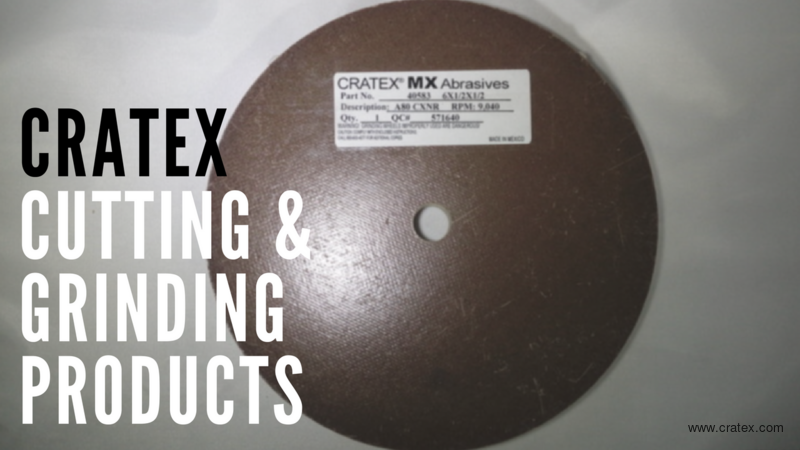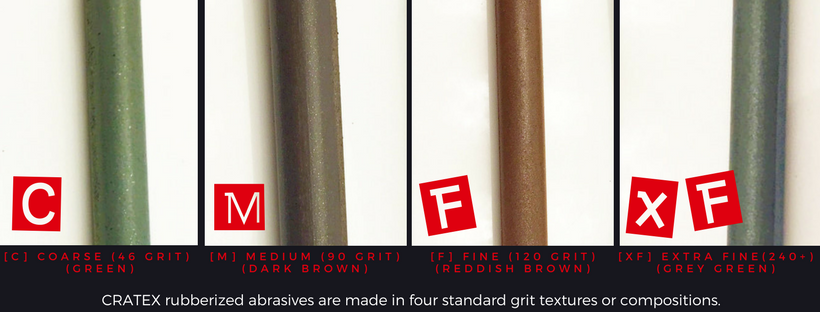CRATEX GRINDING WHEELS
What is Grinding?
Grinding (or abrasive cutting) is a machining operation that results in light cuts made by different abrasives. The tools used the most for grinding is a grinding wheel.
Grinding wheel is an abrasive cutting tool used to grind down, polish or cut different material, like metal or glass. It is composed of an abrasive compound, so it uses thousands of small abrasive grains distributed across the wheel and held together by a certain bonding material to wear away the surface. Each abrasive grain acts like a small cutting tool that passes over the workpiece and leaves a smooth surface. Dull abrasive grains break away from the bonding material, so the process of grinding sharpens the wheel. That way new sharp points are exposed, and a new cycle starts.
Grinding is used as a finishing process, and different grit sizes are responsible for finer or rougher grinding passes. The wheel you will use depends on the metalwork in question. Choosing the right wheel is essential, because if the chosen wheel is wrong for your project, you’ll end up losing time and money.
Chapter 1 of this article will present different grinding wheels and their basic applications, which should help choose the right tool for the job.
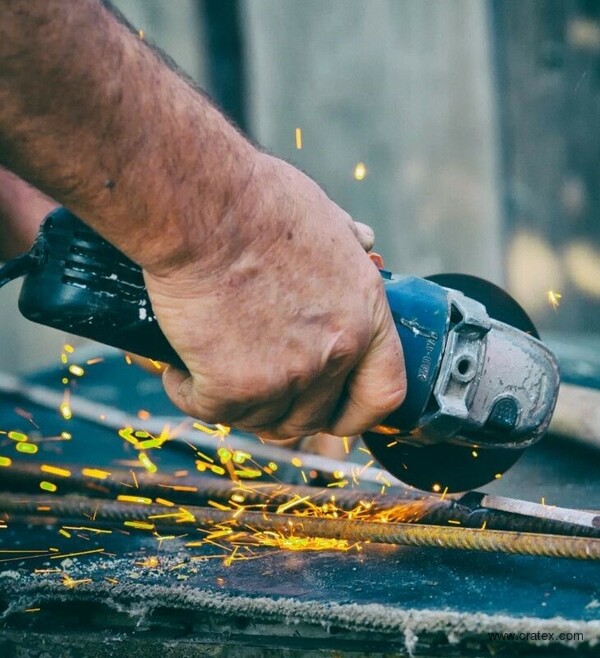
Click the icon to jump to the desired section
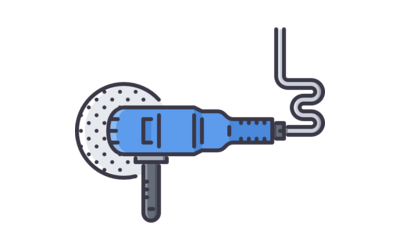
CHAPTER 1
CRATEX Abrasive Cutting & Grinding Products
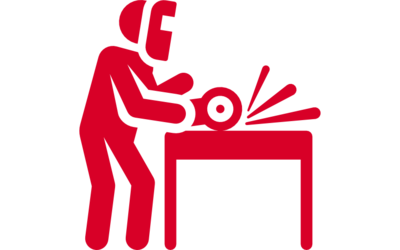
CHAPTER 2
Grinding Machines

CHAPTER 3
Dressing of Grinding Wheels
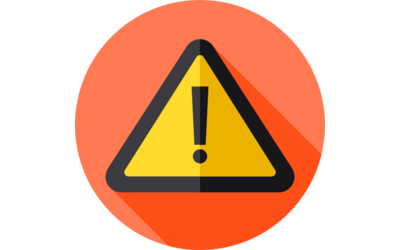
CHAPTER 4
Safety Instructions

CHAPTER 5
How Grinding Wheels Are Made
CRATEX Abrasive Cutting & Grinding Products
CHAPTER 1
In this chapter will talk about various CRATEX grinding wheels, including the Spedecut cut-off and grinding wheels, and MX abrasives. The products presented are available for online purchase, but in case there is a need for non-standard size, shape or composition, contact us here and we’ll do our best to meet all your special requirement
1. CRATEX Rubber Abrasive Wheels
CRATEX grinding wheels are rubber-bonded, premium-quality silicon carbide abrasives of maximum endurance. They are produced in two types of bonds: standard and hard bond. The standard bond has a unique cushioning action, it provides smooth and soft cut without digging into the surface of the workpiece. It is ideal for smoothing and polishing metallic or non-metallic surfaces. It resists smearing or clogging and provides a perfect finish without losing dimensional tolerance and control. Hard-bond wheels have higher cutting power than the standard-bond wheels and are perfect for removing burrs on hard metals, like stainless steel. They can also be used for light metal removal. Hard bond (HB) is not available in kits and minimum quantities are required.
All grinding wheels come in four grits: Coarse (green), Medium (dark brown), fine (reddish brown) and Extra Fine (grey green). The grit depends on the metal and desired finishing action.
CRATEX large straight-edge wheels are perfect for removing rust, heat marks, tarnish, scratches, corrosion and excess solder.
CRATEX small grinding wheels have either a tapered or straight edge. Tapered or shaped wheels are extremely versatile which makes them ideal for fine operations on small and delicate parts. Straight wheels can be mounted on conventional portable motor tools. They are used on operations that require control of metal removal.
2. CRATEX MX Abrasives
MX products are made of premium brown aluminum-oxide. They are cotton-backed laminate-bond abrasives are much more aggressive and firmer than CRATEX rubber bond products. The difference between the two abrasives is that MX bond holds abrasive grains until they are won while abrasive grains get pushed back into the rubber material during use and they fall out as the rubber gets worn away.
The unique construction of MX abrasives gives them an amazing ability to grind, deburr and finish in one operation, because they contain characteristics of three types of abrasives: resinoid, vitrified and rubber-bonded. They do an amazing job with edge breaking, cleaning welds and blending machine lines, and can reduce finishing steps by half.
MX abrasives are available in two different bonds - latex and resin. Latex bonds are typically used for light deburring, blending, and finishing and they come in two grades – soft bond (for general purpose) and medium bond (medium-aggressive). Resin-bonded abrasives are used for light to medium stock removal and they also come in two grades – hard bond (aggressive) and extra bond (very aggressive).
CRATEX offers unmounted and mounted MX wheels of different sizes, grits and bonds, as well as Mounted MX wheels kit, so make sure you check out the offer below!
Grinding Machines
CHAPTER 2
There are grinders for round parts and grinders for flat surfaces. Those for round parts include machines like cylindrical and centerless grinders, and those for flat surfaces are called surface grinders. There are also form grinders (they move the workpiece and the wheel or just the wheel along different axes to grind precisely contoured surfaces) and tool & cutter grinders (for production and sharpening of cutting tools).
Various machines can be used for abrasive cutting such as bench grinders, industrial grinding machines, different hand power tools (such as die grinders or angle grinders) or grindstones.
Grindstones are round sharpening stones typically made from sandstone, mounted on grindstone machines that have speed-control pedals.
Angle or side grinder is used both for abrasive cutting and polishing. The angles grinders are powered by either an electric motor, compressed air or petrol engine. They are made with an adjustable guard for safety and additional side-handle for operations that require the usage of both hands.
There are a wide variety of side grinders on the market, so you’ll be able to find the perfect one for the project you’re working on. One of the main things to consider is the motor strength and the disc size, and the rule is – the greater the power, the bigger the disc. Common angle grinder discs are 4", 4.5", 5", 6", 7", 9" and 12".
Other specifications that could make a lot of difference are the power source, rpm and the size of the mandrel. Depending on the power source, angle grinders can be pneumatic, which have much smaller discs and are generally used for easier, more precise work, and electric, which are used for heavy-duty jobs. Although small electric and large pneumatic grinders do exist, smaller electric grinders have a tougher time maintaining adequate power, whereas pneumatic grinders can be both small and light, but equally powerful.
Depending on the operation, different kinds of discs can be used on these grinders, such as diamond-blade cut-off discs, abrasive grinding wheels, grinding stones, sanding discs, polishing pads and wire brush wheels.
Die grinders and rotary tools and can be used for grinding (with bonded abrasive stones called mounted points/stones or grinding points), but sanding (with coated abrasives like mounted sand paper drums), honing (with fine-grit mounted points), polishing or buffing (with cloth or fiber drums and polishing compound), lapping (with mounted lap and lapping compound) and machining (with drill bits, end mills or burrs) as well, and there is no conceptual difference between the two tools. However, over time their names started to refer more to two same tools used for two different operations: die grinder refer more to the pneumatic, heavy-duty tools, while rotary tools refer more the electric tools used for lighter tasks.
CRATEX Rotary Hand-piece CTX-800 is a precision air tool with different speed options. It has a high torque and construction made from rugged stainless-steel which makes it extremely light and perfect for all kinds of precision grinding, polishing and finishing operations. The tool has a collet that can be changed easily and that can take 1/8'' and 3/32'' diameter shanks and mandrels.
Bench grinders are most commonly seen in residential basements and garages and are standard equipment in machine shops. The name tells us a lot about the way the tool is being used – it is a bench-top type grinder that can be used for different operations depending on the type of wheels that are mounted.
Dressing of Grinding Wheels
CHAPTER 3
Normally, grinding wheels are self-sharpening tools, but only to a certain extent. Occasional dressing (trimming) or trueing is required for optimal use. Dressing is cleaning operation. To dress a wheel means to remove the top layer in the purpose of exposing the fresh, sharp grains and returning the wheel to its original state. Truing achieves a concentric geometry between the periphery of the wheel and the spindle on which the wheel is mounted.
Grinding wheel dressing can be done by different tools, such as:
- Dressing sticks, which are abrasive sticks usually made from the same materials, only with a strong bonding agent. They’re mostly used for dressing smaller conventional wheels (e.g. saucer and cup-shaped). The grinding stick is held against the wheel surface, which caused excess bond removal;
- Star dressers, or mechanical dressers, are long hand tools with free-running discs or star-shaped cutters on one end. The dressing is performed by turning the grinding wheel off first and then applying the star dresser’s head with force on the grinding wheel that is slowing down; they’re mostly used for coarse conventional wheels;
- Diamond dressers are diamond tools with a short handle and either a broad surface with small embedded diamonds on one end or a single diamond brazed into the tip. The dresser is placed in a tool holder and held against the surface of the running wheel.
CRATEX offers four different square dressing blocks each available in four different grits that are perfect for dressing, truing and shaping different kinds of grinding wheels. The shape is quite easy to handle, and the structure makes it a long-lasting dresser that enables you to achieve optimum performance from all your wheels.
Best seller: Dressing stick 6'' x 1/2'' x ½''
How to Dress a Grinding Wheel
The procedure of dressing a grinding wheel would be as follows: the dresser is placed on a work-rest, up to 1/8'' away from the wheel face, under a slight angle (5-20 degrees). Light pressure should then be applied in a straight line across high points of the grinding wheel until a smooth and even surface is obtained. Important is to note you shouldn't run the wheel at full speed until all signs of imbalance are removed. After the wheel has been shaped, it can be run at full speed for a minute or longer, after which the work can be applied.
Safety Instructions
CHAPTER 4
The manufacturers have a great responsibility to produce grinding wheels that are safe to use, but no matter how careful they are during the production, they have very little control over the products once they are shipped and delivered to the customer. The consumers are the ones who should make sure that the wheels are handled, stored, mounted and maintained properly. If not, their behavior can contribute to an unfortunate accident resulting in painful or debilitating injuries to both the operator or others present.
It is advisable that the storage room has a constant level of temperature and humidity since the variations ca damage the bonds in some wheels. The wheels should also be protected from banging and kept in a secured spot. To avoid bumping or dropping them, pay special attention to the way you handle them.
The Ring Test
Grinding wheels are breakable and can be extremely dangerous if used damaged. They can contain microscopic cracks in them which will cause them to explode at high speeds and send shrapnel flying across your workspace in all directions. It is essential to inspect every grinding wheel before you mount it and use it, regardless if it is a used one or it’s brand new that you took right out of the box. Remember – the wheel can seem to be in a perfect condition, but that might not be the case.
Since a cracked wheel can cause serious injury to the human body, and be lethal even, it is fortunate that there is a quick and simple way to test if your wheel is good to go or not. This is determined by a Ring test, and the name is self-explicatory, really: the grinding wheel is hanged on a screwdriver blade and suspended in the air. Next, you’ll visually divide the grinding wheel into 8 equal parts (best is to imagine pizza slices), you’ll take the second screwdriver by the blade, and you’ll tap 8 times, once in each slice with it’s handle. You’ll start at the top, then the bottom, left and right, following the cross shape, and then in remaining parts.
A high-pitched ring sound will tell you that the wheel is in perfect condition, and if you don’t hear it, but hear a dull thud, it means that the wheel has cracks in it.
Safety Gear
Angle grinders produce sparks when grinding ferrous metals and shards when cutting other materials. In addition, there is a possibility the blades could break, so safety goggles or a full-face shield and protective clothing (work gloves, fire-retardant clothing) is a must when grinding. Otherwise, the risk of seriously injuring your face damaging your eyesight is great. Angle grinders should always be used with their guard and handle, and the workpiece should always be firmly secured in a vise. Hearing protection is also necessary, as the grinders are often very loud, especially when cutting. Since abrasive cutting generates a lot of dust, different kinds of masked can be used depending on the material you’re working on.
When working on a bench grinder, it is essential to note the maximum rpm ratings that are printed on the wheel label. The rpm of the grinder must be either equal or lower than the wheel’s rpm. An overspeeding grinding wheel is bound to explode, which can be lethal. Wheel guards are there to intercept the exploding fragments, so make sure you never use a bench grinder without the wheel guards.
How Are Grinding Wheels Made
CHAPTER 5
#1 Grinding Wheel Evolution – From Sandstone to Superabrasives
Grinding operations, and therefore grinding wheels, have had an important place in the manufacturing industry for more than 150 years. The rapid industrialization that took over the world during the mid-19th and beginning of the 20th century transformed the society from an agrarian into an industrial one and caused the development of large spectrum of industries. The demand for all sorts of tools, including the grinding wheels was on the rise, so people constantly sought room for improvement.
Modern-day industries cannot imagine a world without grinding wheels anymore since they are used by nearly every manufacturing company for wide variety of operations ranging from cleaning to cutting steel and masonry blocks. But, long before superabrasives and CNC machines, there was sandstone. It is probably the earliest abrasive made of quartz mineral grains that were bonded with some natural cement and used to sharpen and polish flint axes.
Then, in the early 1800s, emery was introduced to United States and Europe from India, and so the time of emery grinding abrasives begins. Emery is a natural mineral that contains corundum and iron and was predominantly used to shape and cut metals. However, importation costs and issues and variable quality of the abrasive encouraged people to explore other options and to seek abrasives that are much cheaper and available than the imported material.
By the 1890s the search led to the development of synthetic silicon carbide and synthetic corundum which eventually led to the discovery of superabrasives that we know today as synthetic cubic boron nitride (CBN), synthetic diamond, seeded-gel aluminum oxide and so on.
At the same time the developers worked on improving the boding material in the grinding wheels as well, as the improved grains were not much without an equally powerful bond. The research led to the introduction of the rubber bond in the early 1940s and vitrified bond by the 1870s.
Like we’ve seen in Chapter 1 there are numerous types of abrasives used for making grinding wheels with all sorts of bonds today, and there is no doubt that the innovation won’t stop here.
#2 Sugar, Spice & Everything Nice – Grinding Wheel Mixture
Abrasive grains and the bonding material are the main but not the only components of the grinding wheel.Different additives are added as well, such as iron-oxide for wheels that cut and grind iron to enhance the metal cutting properties, or the mineral cryolite that lubricates the abrasives. Powdered and liquid resins are added to bond all these ingredients together.
Today, a computer program automatically scales and weighs various ingredients, and the process starts by adding powdered resin and additives into the mixer first. After about a minute the abrasives and liquid abrasives are added with care. After another five minutes of turning, the mixture reaches the consistency of a damp beach sand and is called “blend”. Last step in this phase is screening out globs and chunks, so that the mixture has a smooth and even texture.
#3 And Then There Was Wheel – The Molding
First, a machine places a reinforcement disc made of fiberglass at the base of the wheel, after which a device called a shuttle spreads the mixture or “blend” into a wheel shaped mold. The diameter and depth of the mold cavity corresponds to the dimensions of the model of the specific grinding wheel. Next, a galvanized steel ring designed to protect the shaft that spins the grinding wheel is placed in the center of the wheel.
Lastly, a pressure force press applying the pressure of up to 5000 pounds per square inch compacts the blend into its final shape and size (by the way, that’s the weight of about 30 cars in case you are wondering).
The mold is then removed from the press and the wheel carefully striped from it. Every single grinding wheel coming off the line is weighed to ensure it meets the design specifications.
#4 Today’s Special - Flambe Wheel
After they’re taken of the line, the wheels are placed into an oven with temperature that rises gradually from 70 to 400 degrees Fahrenheit over a period of 24 hours. Of course, the temperature can vary depending on the types of wheels and ovens (e.g. vitrified bonds are fired to temperatures between 1700-2300 degrees Fahrenheit). The firing process cures the resin and bonds all the ingredients together.
When the grinding wheels come out, they’re hard as a rock and are resistant to heat produced by the high-speed grinding and are resistant to cleaning solvents.
#5 And Voila! – A Grinding Wheel
After the wheels are taken out of the oven, they are transferred to the finishing area. The last steps concerting the shaping of the wheels are: reaming the arbor holes, making the wheel circumference concentric with the edges, adjusting the shape and thickness of the wheel or creating special contours if necessary and balancing large wheels to reduce vibration during grinding. The extent of the grinding wheel quality inspection will depend on the size and the use of the wheel. Typically, larger wheels (over 6 inches in diameter) are thoroughly inspected and tested as they can be extremely dangerous if they break. As for the other wheels, the manufacturer usually monitors the quality of the material used and the production process.
The last step of the production process is labeling. Labeling is conducted by automated machinery that transfers the wheels from a station to station. The information about the manufacturer is usually labeled on the front of the wheel and the safety warnings on the back. The wheels are then packed, shipped and delivered to your home address!
